Remove the baffle plate (A).
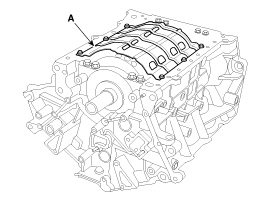
Use fender covers to avoid damaging painted surfaces.
To avoid damage, unplug the wiring connectors carefully while holding the connector portion.
Mark all wiring and hoses to avoid misconnection.
Inspect the timing chain before removing the cylinder head.
Turn the crankshaft pulley so that the No.1 piston is at top dead center (TDC).
Remove the engine assembly from the vehicle.
(Refer to Engine And Transmission Assembly - "Engine And Transmission Assembly")
Remove the drive plate and adapter plate.
(Refer to Cylinder Block - "Drive Plate")
Attach the engine to engine stand for disassembly.
Remove the exhaust manifold.
(Refer to Intake And Exhaust System - "Exhaust Manifold")
Remove the intake manifold.
(Refer to Intake And Exhaust System - "Intake Manifold")
Remove the timing chain.
(Refer to Timing System - "Timing Chain")
Remove the water temperature control assembly.
(Refer to Cooling System - "Water Temperature Control Aassembly")
Remove the cylinder head.
(Refer to Cylinder Head Assembly - "Cylinder Head")
Remove the oil pump.
(Refer to Lubrication System - "Oil Pump")
Remove the oil filter body.
(Refer to Lubrication System - "Oil filter body")
Remove the upper oil pan.
(Refer to Lubrication System - "Oil Pan")
Remove the baffle plate (A).

Remove the rear oil seal case (A).
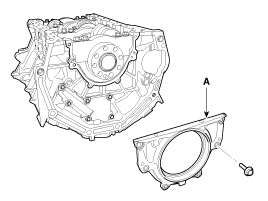
Check the connecting rod end play.
(Refer to Cylinder Block - "Piston And Connecting Rod")
Check the connecting rod cap oil clearance.
(Refer to Cylinder Block - "Piston And Connecting Rod")
Remove the piston and connecting rod assemblies.
(Refer to Cylinder Block - "Piston and Connecting Rod")
Remove the crankshaft main bearing cap and check oil clearance.
Check the crankshaft end play.
Remove the crankshaft.
Lift the crankshaft (A) out of engine, being careful not to damage journals.
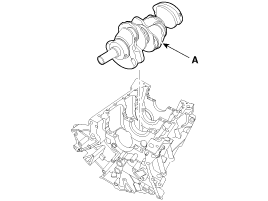
Arrange the main bearings and thrust bearings in the correct order.
Check the crankshaft bearing oil clearance.
To check main bearing-to-journal oil clearance, remove the main bearing caps and bearing halves.
Clean each main journal and bearing half with a clean shop tower.
Place one strip of plastigage across each main journal.
Reinstall the bearings and caps, then torque the bolts.
Tightening torque
No.1~8 : 49.0 N.m (5.0 kgf.m, 36.2 lb-ft) + 90°
No.9~16 : 19.6 N.m (2.0 kgf.m, 14.5 lb-ft)+ 120°
No.17~24 :
29.4 ~ 31.4 N.m (3.0 ~ 3.2 kgf.m, 21.7 ~ 23.1 lb-ft)
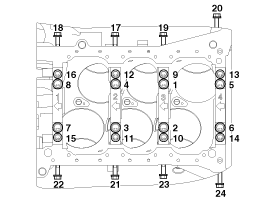
Do not turn the crankshaft.
Remove the cap and bearing again, and measure the widest part of the plastigage.
Standard oil clearance :
0.022 ~ 0.040 mm (0.0009 ~ 0.0016 in.)
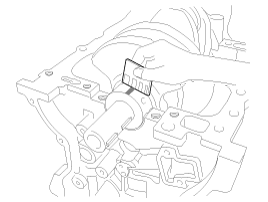
If the plastigage measures too wide or too narrow, remove the upper half of the bearing, install a new, complete bearing with the same color mark (select the color as shown in the next column), and recheck the clearance.
Do not file, shim, or scrape the bearings or the caps to adjust clearance.
If the plastigage shows the clearance is still incorrect, try the next larger or smaller bearing (the color listed above or below that one), and check clearance again.
If the proper clearance cannot be obtained by using the appropriate larger or smaller bearings, replace the crankshaft and start over.
If the marks are indecipherable because of an accumulation of dirt and dust, do not scrub them with a wire brush or scraper. Clean them only with solvent or detergent.
Crankshaft bore mark location
Letters have been stamped on the block as a mark for the size of each of the 4 main journal bores.
Use them, and the numbers or bar stamped on the crank (marks for main journal size), to choose the correct bearings.
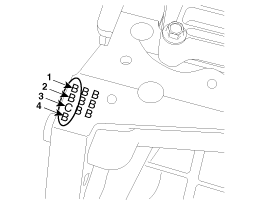
Class | Mark | Inside Diameter |
a | A | 73.500 ~ 73.506 mm (2.8937 ~ 2.8939 in.) |
b | B | 73.506 ~ 73.512 mm (2.8939 ~ 2.8942 in.) |
c | C | 73.512 ~ 73.518 mm (2.8942 ~ 2.8944 in.) |
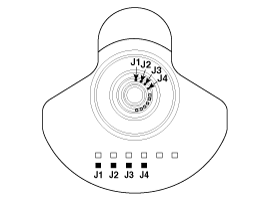
Class | Mark | Outside Diameter Of Journal |
I | 1 or A | 68.954 ~ 68.960 mm (2.7147 ~ 2.7150 in.) |
II | 2 or B | 68.948 ~ 68.954 mm (2.7145 ~ 2.7147 in.) |
III | 3 or C | 68.942 ~ 68.948 mm (2.7142 ~ 2.7145 in.) |
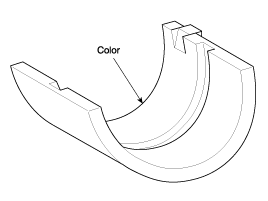
Class | Mark | Thickness Of Bearing |
E | Blue | 2.277 ~ 2.280 mm (0.0896 ~ 0.0897 in.) |
D | Black | 2.274 ~ 2.277 mm (0.0895 ~ 0.0896 in.) |
C | Red | 2.271 ~ 2.274 mm (0.0894 ~ 0.0895 in.) |
B | Green | 2.268 ~ 2.271 mm (0.0893 ~ 0.0894 in.) |
A | Yellow | 2.265 ~ 2.268 mm (0.0892 ~ 0.0893 in.) |
Crankshaft Bore Identification Mark | ||||
a(A) | b(B) | c(C) | ||
Crankshaft Identification Mark | 1 or A | A (Yellow) | B (Green) | C (Red) |
2 or B | B (Green) | C (Red) | D (Black) | |
3 or C | C (Red) | D (Black) | E (Blue) | |
Check crankshaft end play.
Using a dial indicator, measure the thrust clearance while prying the crankshaft back and forth with a screwdriver.
Standard end play :
0.10 ~ 0.28 mm (0.0039 ~ 0.0110 in.)
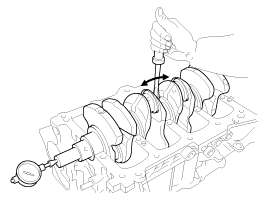
If the end play is greater than maximum, replace the thrust bearings as a set.
Thrust bearing thickness :
2.41 ~ 2.45 mm (0.0949 ~ 0.0964 in.)
Inspect main journals and crank pins
Using a micrometer, measure the diameter of each main journal and crank pin.
Main journal diameter :
68.942 ~ 68.960 mm (2.7142 ~ 2.7149 in.)
Crank pin diameter :
54.954 ~ 54.972 mm (2.1635 ~ 2.1642 in.)
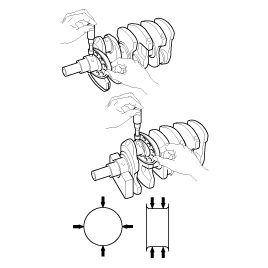
Thoroughly clean all parts to be assembled.
Before installing the parts, apply fresh engine oil to all sliding and rotating surfaces.
Replace all gaskets, O-rings and oil seals with new parts.
Install the main bearings.
Upper bearings have an oil groove of oil holes; Lower bearings do not.
Align the bearing claw with the claw groove of the cylinder block, push in the 4 upper bearings(A).
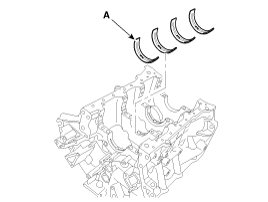
Align the bearing claw with the claw groove of the main bearing cap, and push in the 4 lower bearings.
Install the thrust bearings.
Install the 2 thrust bearings(A) under the No.3 journal position of the cylinder block with the oil grooves facing outward.
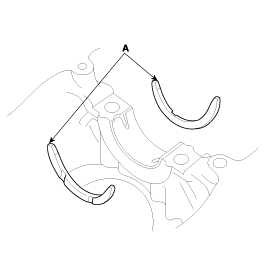
Place the crankshaft(A) on the cylinder block.

Place the main bearing caps on cylinder block.
Install the main bearing cap bolts.
Install and uniformly tighten the bearing cap bolts, in several passes, in the sequence shown.
Tightening torque
Main bearing cap bolt
No.1~8 : 49.0 N.m (5.0 kgf.m, 36.2 lb-ft) + 90°
No.9~16 : 19.6 N.m (2.0 kgf.m, 14.5 lb-ft) + 120°
No.17~24 :
29.4 ~ 31.4 N.m (3.0 ~ 3.2 kgf.m, 21.7 ~ 23.1 lb-ft)

Always use new main bearing cap bolts.
If any of the bearing cap bolts are broken or deformed, replace it.
Use the SST( 09221-4A000 ), install main bearing cap bolts.
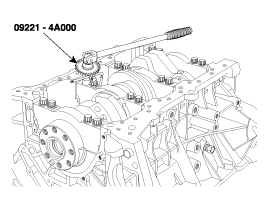
Check that the crankshaft turns smoothly.
Check crankshaft end play.
Install the piston and connecting rod assemblies.
(Refer to Cylinder Block - "Piston and Connecting rod")
Install the rear oil seal case(A).
Tightening torque :
9.8 ~ 11.8 N.m (1.0 ~ 1.2 kgf.m, 7.2 ~ 8.7 lb-ft)

Clean the sealing face before assembling two parts.
Remove harmful foreign materials on the sealing face before applying sealant
Before assembling rear oil seal case, the liquid sealant THREE BOND 1217H should be applied to the rear oil seal case.
The part must be assembled within 5 minutes after sealant was applied.
Apply sealant to the inner threads of the bolt holes.

Install the rear oil seal.
(Refer to Cylinder Bolck - "Rear Oil Seal")
Install the baffle plate.
Install and uniformly tighten the baffle plate bolts, in several passes, in the sequence shown.
Tightening torque :
9.8 ~ 11.8 N.m (1.0 ~ 1.2 kgf.m, 7.2 ~ 8.7 lb-ft)
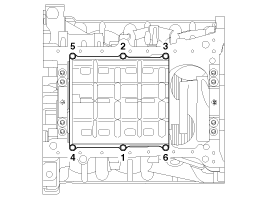
Install all other parts in reverse order of removal.
In case the crankshaft is replaced with a new one, select the proper connecting rod bearing according to the pin journal mark on the crankshaft.
Connecting rod bearing selection
(Refer to Cylinder Block - "Piston and Connecting Rod")